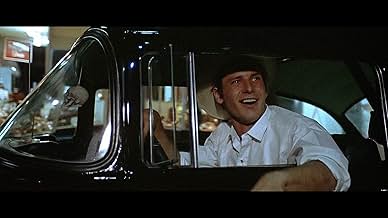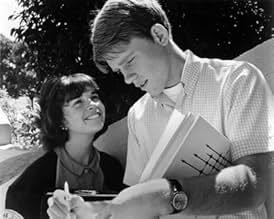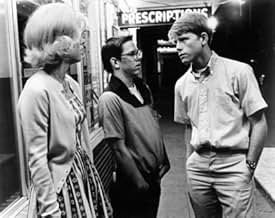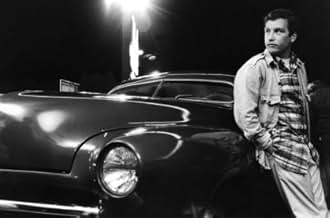American Graffiti
- 1973
- Tous publics
- 1h 50min
Steve et Curt, deux amis tout juste diplômés, sortent se divertir pour une dernière nuit en compagnie de leurs camarades du lycée avant de partir à la fac.Steve et Curt, deux amis tout juste diplômés, sortent se divertir pour une dernière nuit en compagnie de leurs camarades du lycée avant de partir à la fac.Steve et Curt, deux amis tout juste diplômés, sortent se divertir pour une dernière nuit en compagnie de leurs camarades du lycée avant de partir à la fac.
- Réalisation
- Scénario
- Casting principal
- Nommé pour 5 Oscars
- 9 victoires et 13 nominations au total
Ron Howard
- Steve
- (as Ronny Howard)
Charles Martin Smith
- Terry
- (as Charlie Martin Smith)
Terence McGovern
- Mr. Wolfe
- (as Terry McGovern)
Kathleen Quinlan
- Peg
- (as Kathy Quinlan)
Avis à la une
"I just love it when guys peel out." -Debbie Dunham
American Graffiti is the best film about teenagers. It actually has a point, unlike the other teenage films where all that they do is get drunk and party. American Graffiti is about different types of teenagers doing different things on the last night that they all have together in 1962 after graduating. They all actually learn about themselves and what they want to do with their lives. One of the older
teenagers, Curt, is planning on leaving the next day. Steve is trying to work out his relationship with Curt's sister, while John and Terry have their own dates for the night. American Graffiti is a wonderful film on many levels. It is both funny and serious. A great direction by George Lucas and a fine cast with Ron
Howard, Richard Dreyfuss, Cindy Williams, Paul LeMat, Charles Martin Smith,
Candy Clark (Oscar-nominated), MacKenzie Phillips, Harrison Ford. One of the
best films of the 70's and the only teen film in my memory that has had the
pleasure of being nominated for Oscar- Best Picture. 10/10 stars.
American Graffiti is the best film about teenagers. It actually has a point, unlike the other teenage films where all that they do is get drunk and party. American Graffiti is about different types of teenagers doing different things on the last night that they all have together in 1962 after graduating. They all actually learn about themselves and what they want to do with their lives. One of the older
teenagers, Curt, is planning on leaving the next day. Steve is trying to work out his relationship with Curt's sister, while John and Terry have their own dates for the night. American Graffiti is a wonderful film on many levels. It is both funny and serious. A great direction by George Lucas and a fine cast with Ron
Howard, Richard Dreyfuss, Cindy Williams, Paul LeMat, Charles Martin Smith,
Candy Clark (Oscar-nominated), MacKenzie Phillips, Harrison Ford. One of the
best films of the 70's and the only teen film in my memory that has had the
pleasure of being nominated for Oscar- Best Picture. 10/10 stars.
This is the ground-breaking work by George Lucas, loosely based on his friends and his experiences as a teenager living in the San Joaquin Valley at the beginning of the 1960s, a time of gentle naiveté and innocence. There are no words to describe the edgy sweetness and humor that permeates this ensemble story of friends and enemies, jocks, brains, and punks maneuvering through the stultifying heat of the last weekend of summer vacation, 1962.
American Graffiti is a comedy, a drama, a tragedy, a musical, and a reminder of what small-town America once was, a mere forty years ago. From its breezy humor to its excruciating last moments (I remember theater-goers stunned in their seats, sobbing after the credits were done), Lucas's first major hit hits home. American Graffiti is pure magic.
American Graffiti is a comedy, a drama, a tragedy, a musical, and a reminder of what small-town America once was, a mere forty years ago. From its breezy humor to its excruciating last moments (I remember theater-goers stunned in their seats, sobbing after the credits were done), Lucas's first major hit hits home. American Graffiti is pure magic.
As many people know, George Lucas is most famous for the fact that he wrote a certain series of fantasy films. Most of those films certainly were a great achievement, but one thing that many Star Wars fans overlook is the other entries in Lucas' list of directorial credits; one of which is this film, American Graffiti. The movie tells the story of the last night in town for a bunch of school kids about to leave to go to college. Now, this might not seem like a great base for a classic movie to work from; and it isn't, it's the handling that makes it great. In spite of his latest batch of movies, Lucas has shown with this movie that he has the talent to create an innovative and groundbreaking movie in spite of the plot. It's this fact that made Star Wars work so well, and it's nice to see the same effort transplanted into an earlier film that doesn't have the special effects and grandiose that Star Wars had. The energy and vitality that Lucas gives his multiple stories makes for a great ride, and American Graffiti is a lot of fun throughout.
The film is most notable for the way that it captures the American youth of the sixties. It benefits from a great soundtrack that adequately helps to achieve this, and includes the likes of Buddy Holly and The Beach Boys. The film takes place in one night, and makes use of a number of different characters and story lines; all of which are interesting and unique. A lot of which are also really funny, and this is where my favourite part of American Graffiti comes in. The film works because it's such a good time, and the way that Lucas shows us that ensures that we have just as good a time as the characters on screen are having. The events that befall the characters in the movie will no doubt touch a nerve with anyone that has gone through childhood - things such as splitting up with your girlfriend, to being forced into doing things that could get you into trouble...all the way to asking an adult to go into a store to buy alcohol for you are shown with great care, and show that Lucas obviously knew what he was doing when he took on this movie. On the whole...it's very good stuff indeed.
The film is most notable for the way that it captures the American youth of the sixties. It benefits from a great soundtrack that adequately helps to achieve this, and includes the likes of Buddy Holly and The Beach Boys. The film takes place in one night, and makes use of a number of different characters and story lines; all of which are interesting and unique. A lot of which are also really funny, and this is where my favourite part of American Graffiti comes in. The film works because it's such a good time, and the way that Lucas shows us that ensures that we have just as good a time as the characters on screen are having. The events that befall the characters in the movie will no doubt touch a nerve with anyone that has gone through childhood - things such as splitting up with your girlfriend, to being forced into doing things that could get you into trouble...all the way to asking an adult to go into a store to buy alcohol for you are shown with great care, and show that Lucas obviously knew what he was doing when he took on this movie. On the whole...it's very good stuff indeed.
I was born at the beginning of the next decade--1970--yet "American Graffiti" was a chord that rippled throughout my life.
My father, who, like George Lucas, grew up in California's Central Valley, said this movie perfectly captured what it was like to grow up there--street cruising, hot rodding, picking up chicks, pulling pranks. Though this movie necessarily sidesteps the boredom inherent in growing up in the pesticide-choked San Joaquin Valley, the place itself is not as important the time it explores. It was a time just before the 1960s descended into the beginning of the end of American culture--the prototypical middle America that existed in almost all its small towns and now has substantively disappeared thanks to the urbanization and suburbanization of much of this country.
The ensemble cast, including so many that went on to become hugely successful in Hollywood--Ron Howard, Cindy Williams (well, with Laverne & Shirley at least), Richard Dreyfuss, and of course Harrison Ford (not to mention Lucas himself)--is handled with great skill from such a young director and reinforces the mystery why Lucas has so horribly mishandled Star Wars Eps. I and II. Lucas simply has been at the Ranch too long and his brilliant career has arrived parked in the garage at a large, entirely perfunctory business and media empire.
Anyway, regardless of Lucas' drift far away from the cutting edge, "American Graffiti" still stands as a kind of monument to his precocity. It is the kind of movie that hits every note with effortless precision, which I think is less the effort of great editing as it is a combination of youthful exuberance and actors and a director at essentially the beginning of their ascent as some of the best in the business.
This movie also withstands the test of time simply because it works magically both for those who have no particular emotional connection to the '60s and for those who were there on nearly equal levels. There is tremendous humor and naturalistic character play and dialog that few can help but be drawn into. Anyone with any sense of history will acknowledge that all the characters are standing at the edge of the deflowering and self-destruction of America in the '60s. It is a time of tremendous innocence, change, and harrowing decisions. The Bay of Pigs, Cuban Missile Crisis, and Vietnam haven't happened yet.
With Iraq and terrorism chewing at our consciousness every day, it's pretty easy for modern youth to identify and yearn for the nostalgia of such innocence.
My father, who, like George Lucas, grew up in California's Central Valley, said this movie perfectly captured what it was like to grow up there--street cruising, hot rodding, picking up chicks, pulling pranks. Though this movie necessarily sidesteps the boredom inherent in growing up in the pesticide-choked San Joaquin Valley, the place itself is not as important the time it explores. It was a time just before the 1960s descended into the beginning of the end of American culture--the prototypical middle America that existed in almost all its small towns and now has substantively disappeared thanks to the urbanization and suburbanization of much of this country.
The ensemble cast, including so many that went on to become hugely successful in Hollywood--Ron Howard, Cindy Williams (well, with Laverne & Shirley at least), Richard Dreyfuss, and of course Harrison Ford (not to mention Lucas himself)--is handled with great skill from such a young director and reinforces the mystery why Lucas has so horribly mishandled Star Wars Eps. I and II. Lucas simply has been at the Ranch too long and his brilliant career has arrived parked in the garage at a large, entirely perfunctory business and media empire.
Anyway, regardless of Lucas' drift far away from the cutting edge, "American Graffiti" still stands as a kind of monument to his precocity. It is the kind of movie that hits every note with effortless precision, which I think is less the effort of great editing as it is a combination of youthful exuberance and actors and a director at essentially the beginning of their ascent as some of the best in the business.
This movie also withstands the test of time simply because it works magically both for those who have no particular emotional connection to the '60s and for those who were there on nearly equal levels. There is tremendous humor and naturalistic character play and dialog that few can help but be drawn into. Anyone with any sense of history will acknowledge that all the characters are standing at the edge of the deflowering and self-destruction of America in the '60s. It is a time of tremendous innocence, change, and harrowing decisions. The Bay of Pigs, Cuban Missile Crisis, and Vietnam haven't happened yet.
With Iraq and terrorism chewing at our consciousness every day, it's pretty easy for modern youth to identify and yearn for the nostalgia of such innocence.
American Graffiti, voted in 1998 to the American Film Institute's list of 100 superlative films, is as good today as it was upon its release in 1973. Countless films (such as Linklater's excellent Dazed and Confused) have borrowed heavily from Lucas' blueprint of multiple characters and storylines punctuated by wall to wall rock music. If possible, you should try to see the 1998 documentary that accompanies the DVD release, as it provides a wealth of information directly from Lucas, Coppola, LeMat, Ford, Clark, Dreyfuss, Howard, and many others about the creation of the film from concept to box-office phenomenon.
The Life and Times of Harrison Ford
The Life and Times of Harrison Ford
Take a look back at Harrison Ford's movie career in photos.
Le saviez-vous
- AnecdotesDue to the low budget, George Lucas was unable to pay all of the crew members. He offered to give many of them a screen credit in lieu of payment, and they accepted. Traditionally, only department heads received screen credit. Giving screen credit to all crew members is now standard, which is why closing credits last so much longer now.
- GaffesThe movie is set in 1962, but a cinema marquee advertises Dementia 13 (1963) (released in 1963). This was done on purpose by George Lucas, because Dementia 13 was Producer Francis Ford Coppola's first movie.
- Citations
Curt Henderson: You're the most beautiful, exciting thing I've ever seen in my life and I don't know anything about you.
- Crédits fousWorded epilogues prior to the credits shows what happen to the characters following the movie. While this has since become commonplace in films, it was considered innovative at the time.
- Versions alternativesOriginally released at 110 minutes; re-edited and re-released in a slightly longer version (112 minutes) in 1978 when many of its then-unknown stars became famous.
- ConnexionsFeatured in 747 en péril (1974)
- Bandes originalesAt The Hop
Written by John Madara, Artie Singer and Dave White (uncredited)
Performed by Flash Cadillac (as Flash Cadillac and The Continental Kids)
Produced by Kim Fowley
Courtesy of Roulette Records:
Meilleurs choix
Connectez-vous pour évaluer et suivre la liste de favoris afin de recevoir des recommandations personnalisées
Détails
- Date de sortie
- Pays d’origine
- Langue
- Aussi connu sous le nom de
- American Graffiti: Locura de verano
- Lieux de tournage
- Sociétés de production
- Voir plus de crédits d'entreprise sur IMDbPro
Box-office
- Budget
- 750 000 $US (estimé)
- Montant brut aux États-Unis et au Canada
- 115 000 000 $US
- Montant brut mondial
- 115 006 690 $US
- Durée
- 1h 50min(110 min)
- Couleur
- Rapport de forme
- 2.39 : 1
Contribuer à cette page
Suggérer une modification ou ajouter du contenu manquant




























